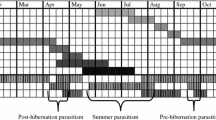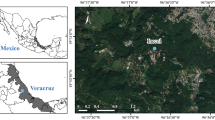Summary
We report studies on the butterfly-hostplant communities in the species-rich area of west central Morocco. Pieridae feeding on Capparales form two distinct ecological guilds: inflorescence feeders and folivores. Several members of each guild may synchronously occur in sympatry. Substantial levels of cannibalism and inter-specific predation occur amongst the inflorescence feeders. No evidence was obtained for segregation of butterfy species on different hosts. Host plants included in the diet of specialists were also used by generalists. Despite substantial differences observed in laboratory trials of larval survivorship on different hostplants, results were congruent for all Pieridae, suggesting that little one-to-one insect-host coevolution has occurred. Host specialization was instead related to the year-to-year stability of host numbers in an area. High levels of pierid infestation occurred on host species with numerically stable populations. Host numerical stability was correlated with habitat type. There is little evidence for segregation of competing inflorescence feeders by hostplant species, but some evidence for segregation by habitat type (particularly by shading levels). We interpret our results as indicating that the hostplant affiliations of Moroccan Capparales-feeding Pieridae are subject to (at best) diffuse coevolutionary effects from hosts and competitors, and are strongly influenced by habitat characteristics.
Similar content being viewed by others
References
Brown KS, Damman AJ, Feeny P (1981) Troidine relationships in southeastern Brazil: natural history and foodplant relationships. J Res Lep 19:199–226
Cappucino N, Kareiva PM (1985) Coping with a capricious environment: a population study of a rare pierid butterfly. Ecology 66:152–161
Carcasson RH (1964) A preliminary study of the zoogeography of african butterflies. East Afr Wildl J 2:122–157
Chew FS (1975) Coevolution of pierid butterflies and their cruciferous foodplants. I. The relative quality of available resources Oecologia (Berlin) 20:117–127
Chew FS (1977a) II The distribution of eggs on potential foodplants. Evolution 31:568–579
Chew FS (1977b) The effects of introduced mustrards (Cruciferae) on some native north american cabbage butterflies (Lep. Pieridae). Atala 5:13–19
Chew FS (1981) Coexistence and local extinction in two pierid butterflies. Am Nat 118:665–672
Chew FS (1986) Searching for chemical defense in the cruciferae, in Biocemical Coevolution (ed. KC Spencer), Pergamon Press (in press)
Chew FS, Robbins (1984) Egg-laying in butterflies. Symp R Ent Soc 11:65–80
Courtney SP (1981) Coevolution of pierid butterflies and their cruciferous foodplants III. Anthocharis cardamines survival, development and oviposition. Oecologia (Berlin) 51:91–96
Courtney SP (1982a) IV. Hostplant apparency and Anthocharis cardamines oviposition Oecologia 52:258–265
Courtney SP (1982b) V. Habitat selection, community structure and speciation. Oecologia (Berlin) 54:101–107
Courtney SP (1983) Notes on the biology of Zegris eupheme Led in Morocco. J Lep Soc 36:132–136
Courtney SP (1986) The ecology of pierid butterflies: dynamics and interactions. Adv Ecol Res 15:51–131
Courtney SP, Courtney S (1982) The ‘Edge-Effect’ in butterfly oviposition: causality in Anthocharis cardamines and related species. Ecol Entomol 7:131–137
Courtney SP, Duggan AE (1983) The population biology of the orange-tip butterfly, Anthocharis cardamines in Britain. Ecol Entomol 8:271–281
Courtney SP, Shapiro AM (1986) The life history, ecology and behavior of a scarce andean butterfly Hypsochila wagenknechti (Pieridae). Stud Neotrop Fauna Envt (in press)
Fox LR (1981) Defense and dynamics in plant herbivore systems Am Zool 21:853–864
Futuyma DJ, Slatkin M (eds) (1983) “Coevolution” Sinauer, Mass.
Gilbert LE (1979) Development of theory in the analysis of insectplant interactions. In: Analysis of Ecological Systems. Horn DJ, Mitchell RD, Stairs AR (eds), Columbus pp 117–154
Gilbert LE, Singer MC (1975) Butterfly ecology. Ann Rev Ecol Syst 6:365–397
Hayes JL (1985) Egg distribution and survivorship in the pierid butterfly Clias alexandra. Oecologia (Berlin) 66:495–498
Hedge IC (1976) A systematic and geographical survey of the old world cruciferae. In: The Biology and Chemistry of the Cruciferae. Vaughan JG, MacLeod AJ, Jones BMG (eds) London: Academic pp 1–45
Higgins LA (1975) The Classification of European. Butterflies London
Higgins LA, Riley ND (1980) A Field Guide to the Butterflies of Britain and Europe London
Jaenike J (1978) On optimal oviposition behavior in phytophagous insects Theor Popul Biol 14:350–356
Janzen DH (1968) Hostlants as islands in evolutionary and contemporary time. Am Nat 102:592–595
Janzen DH (1973) Hostplants as islands II. Competition in evolutionary and contemporary time. Am Nat 107:786–790
Jordan CT (1981) Population biology and hostplant ecology of caper-feeding pierid butterflies in northeastern Mexico Ph.D. Dissertation, University of Texas, Austin p 163
Karban R, Courtney SP (1987) Intraspecific host plant choice: lack of consequences for Streptanthus tortuosus (Cruciferae) and Euchloe hyantis (Lepidoptera: Pieridae). Oikos (in press)
Kellner CV, Shapiro AM (1983) Ecological interations of Pieris brassicae L. (Lep. Pieridae) and native pierinae in Chile Stud Neot Fauna Envt 18:53–64
Lawton JH, Strong DR (1981) Community patterns and competition in folivorous insects. Am Nat 118:317–338
Lorkovic Z (1968) Systematisch-genetische und okologische Besonderheiten von Pieris ergane Hbn (Lepidoptera Pieridae). Mitt Schweiz Ent Ges 41:233–244
Maire R (1952–1976) Flore de l'Afrique de nord Lecevalier, Paris
Ohsaki R (1980) Comparative population dynamics of three Pieris butterflies, P. rapae, P. melete and P. napi living in the same area II. Utilization of patchy habitats by adults through migratory and non-migratory movements Res Popul Ecol 22:163–183
Opler PA (1974) Studies on neartic Euchloe pt. 7: comparative life histories, hosts and the morphology of immature stages J Res Lep 13:1–20
Peterson B (1954) Egg-laying and habitat selection in some Pieris species Entomol Tidskr 74:194–203
Polunin O, Smythies BE (1973) Flowers of Southwest Europe Oxford University Press
Powell H (1932) Pupation of Zegris eupheme meridionalis Led Proc Entomol Soc 6:52–54
Robbins RD, Henson PM (1986) Why Pieris rapae is a better name than Artogeia rapae (Pieridae). J Lepid Soc (in press)
Rodman JE, Chew FS (1980) Phytochemical correlates of herbivory in a community of native and naturalized cruciferae Biochem Syst Ecol 8:43–50
Rothschild M, Schoonhoven LM (1977) Assessment of egg-load by Pieris brassicae (Lepidoptera: Pieridae) Nature 266:352–355
Schoener TW (1983) Field experiments on interspecific competition Am Nat 122:240–285
Scriber JM, Slansky F (1981) The nutritional ecology for immature insects Ann Rev Ent 26:183–211
Shapiro AM (1971) Occurrence of a latent polyphenism in Pieris virginiensis (Lep. Pieridae) Entomol News 82:13–16
Shapiro AM (1975) Ecological and behavioral aspects of coexistence in six crucifer-feeding pierid butterflies in the central Sierra Nevada. Am Midl Nat 93:424–433
Shapiro AM (1976) The role of watercress (Nasturtium officinale) as a host of native and introduced Pierid butterflies in California. J Res Lep 14:158–168
Shapiro AM (1981a) The pierid red-egg sydrome. Am Nat 117:276–294
Shapiro AM (1981b) Egg mimics of Streptanthus (Cruciferae) deter oviposition by Pieris sisymbrii (Lep. Pieridae). Oecologia (Berlin) 48:142–143
Singer MC (1984) Butterfly-hostplant relationships: host quality, adult choice and larval success. Symp R Entomol Soc 11:81–88
Slobodkin LB, Smith FE, Hairston NG (1967) Regulation in terrestrial ecosystems, and the implied balance of nature. Am Nat 101:109–124
Smiley JT (1978) Plant chemistry and the evolution of host specificity: new evidence from Heliconius and Passiflora. Science 201:745–747
Southwood TRE (1977) Habitat, the templet for ecological strategies. J Anim Ecol 46:337–365
Strong DR, Lawton JH, Southwood TRE (1984) Insects on plants Oxford: Blackwell Science Publications
Thompson JN (1983) Interaction and Coevolution Wiley Interscience
Tutin TA (1964) Flora Europaea Cambridge: Cambridge University Press
Warren M (1985) The biology and status of the wood shite butterfly, Leptidea sinapis L. (Lep. Pieridae) in the British Isles Ent Gaz
Wiens JA (1977) On competition and variable environments. Am Sci 65:590–597
Wiklund C (1975) The evolutionary relationship between adult oviposition preferences and larval host plant range in Papilio machaon L. Oecologia (Berlin) 18:185–197
Wiklund C, Ahrberg C (1978) Hostplants, nectar and source plants and habitat selection of males and females of Anthocharis cardamines L. (Lepidoptera). Oikos 31:169–183
Wyatt C (1956) Lepidoptera collecting in the atlas mountains of Morocco. Lepid News 10:214–222
Yamamoto M (1981) Comparison of population dynamics of two pierid butterflies, Pieris rapae crucivora and P. napi nesis living in the same area and feeding on the same plant in Sapporo, Northern Japan J Fac, Sci Hokkaido University 22:202–249
Yamamoto M (1983) Microhabitat segregation in two closely related pierid butterflies Jap J Ecol 33:263–270
Author information
Authors and Affiliations
Rights and permissions
About this article
Cite this article
Courtney, S.P., Chew, F.S. Coexistence and host use by a large community of Pierid butterflies: habitat is the templet. Oecologia 71, 210–220 (1987). https://doi.org/10.1007/BF00377286
Received:
Issue Date:
DOI: https://doi.org/10.1007/BF00377286




